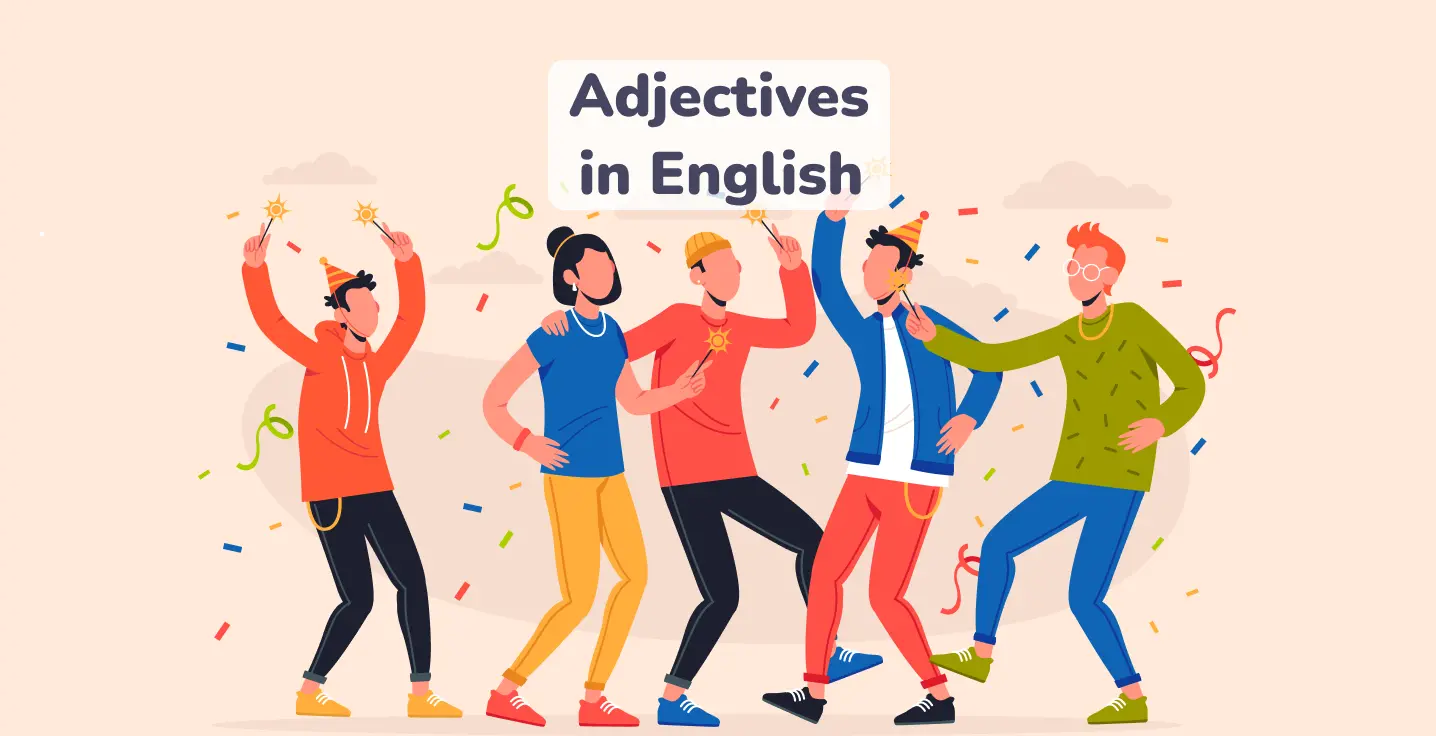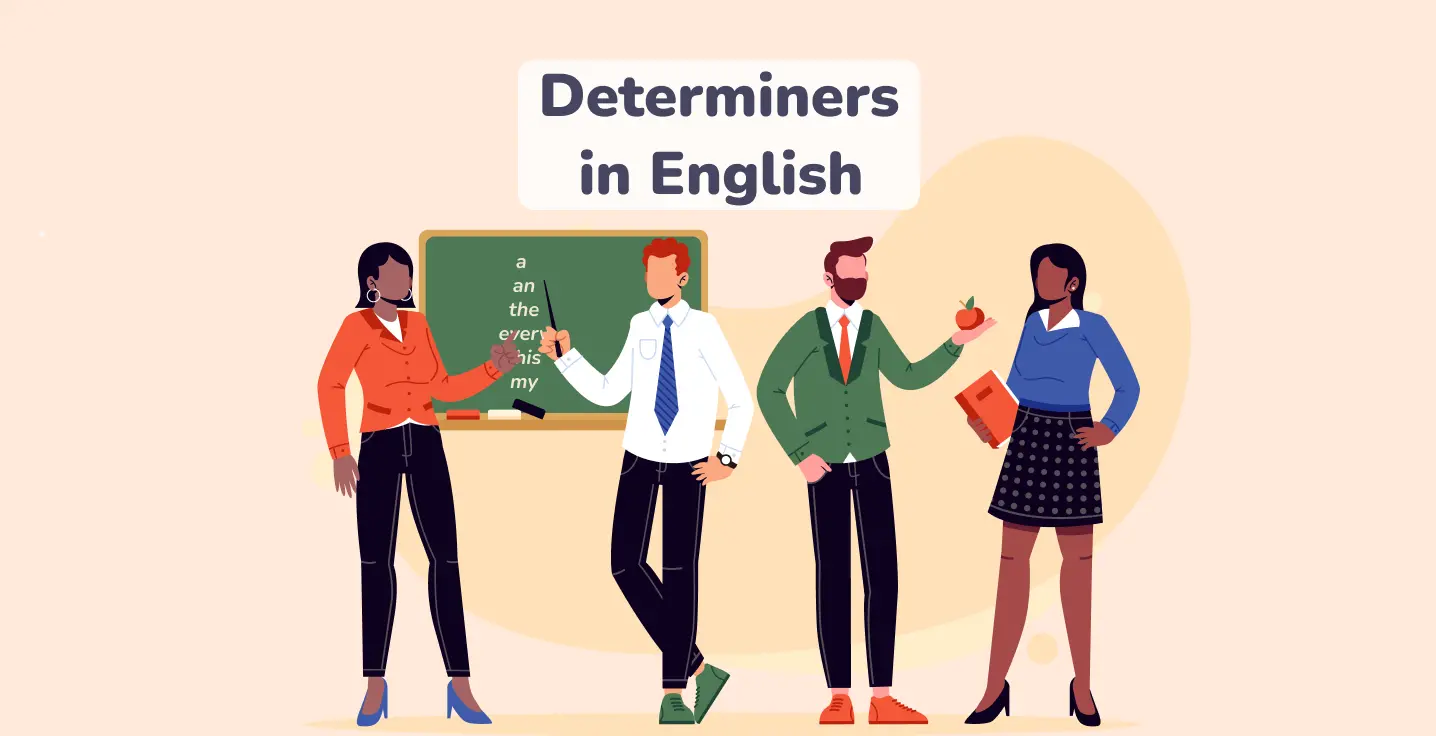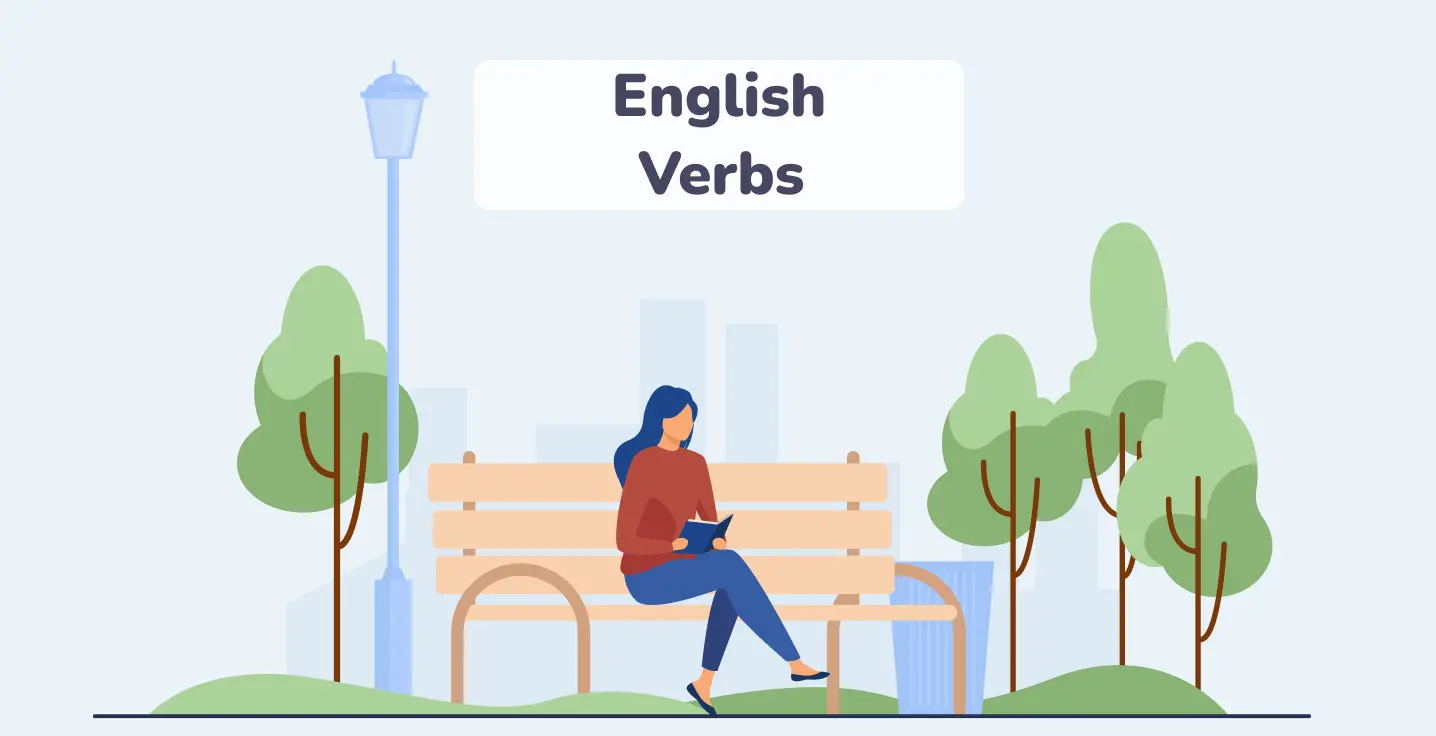What is an adjective?

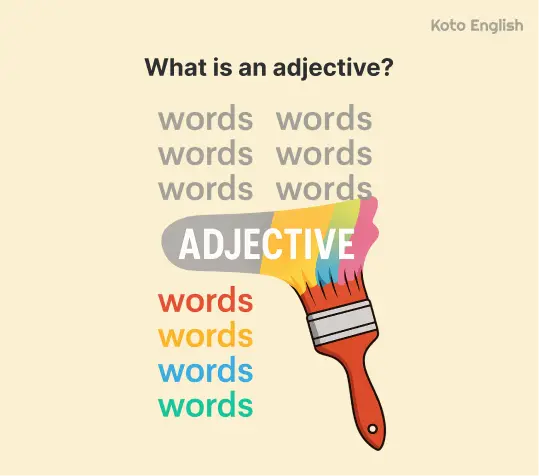
Adjectives, in a sense, are the paint on your words, allowing nouns and pronouns to come alive and become expressive and impossible to gloss over.
Answering the question “What are adjectives?” on a deeper level, these words let you add personality, mood, or color to what you’re talking about. They turn bald statements into associations that have been written or expressed.
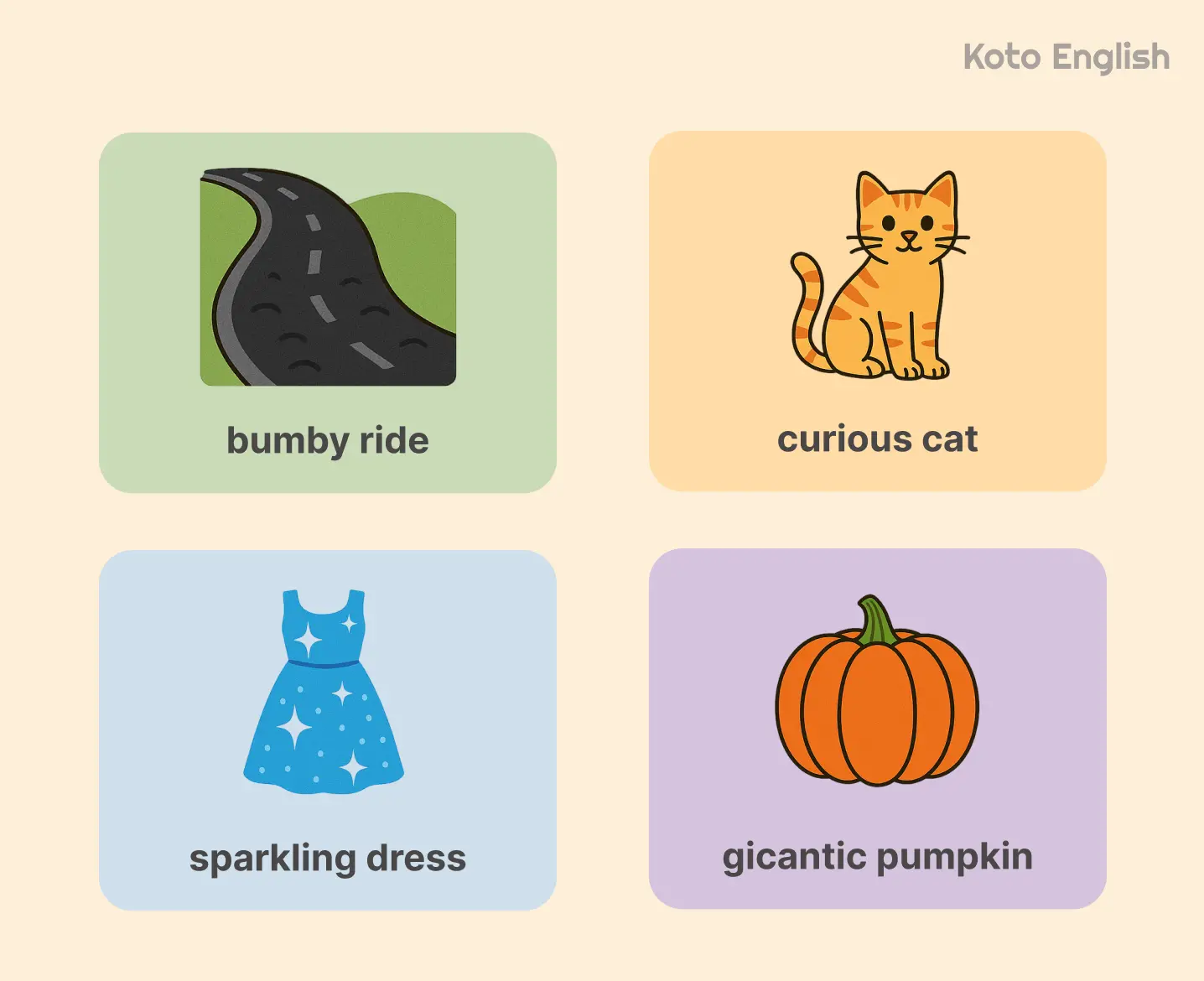

Use adjectives liberally and you make your sentences richer, alive and emotional. You should make the difference between pure facts, which may be dull to read or listen to, and descriptive words, which make your writing/speech stick in the memory.
Basic structure:
[Adjective] + [noun]
Read on to see these parts of speech in action, peppered throughout some real-life adjectives examples. They bring inanimate objects to life and give common nouns extra personality and color to your speaking, writing, and reading.
Level up your English with Koto!
Types of adjectives
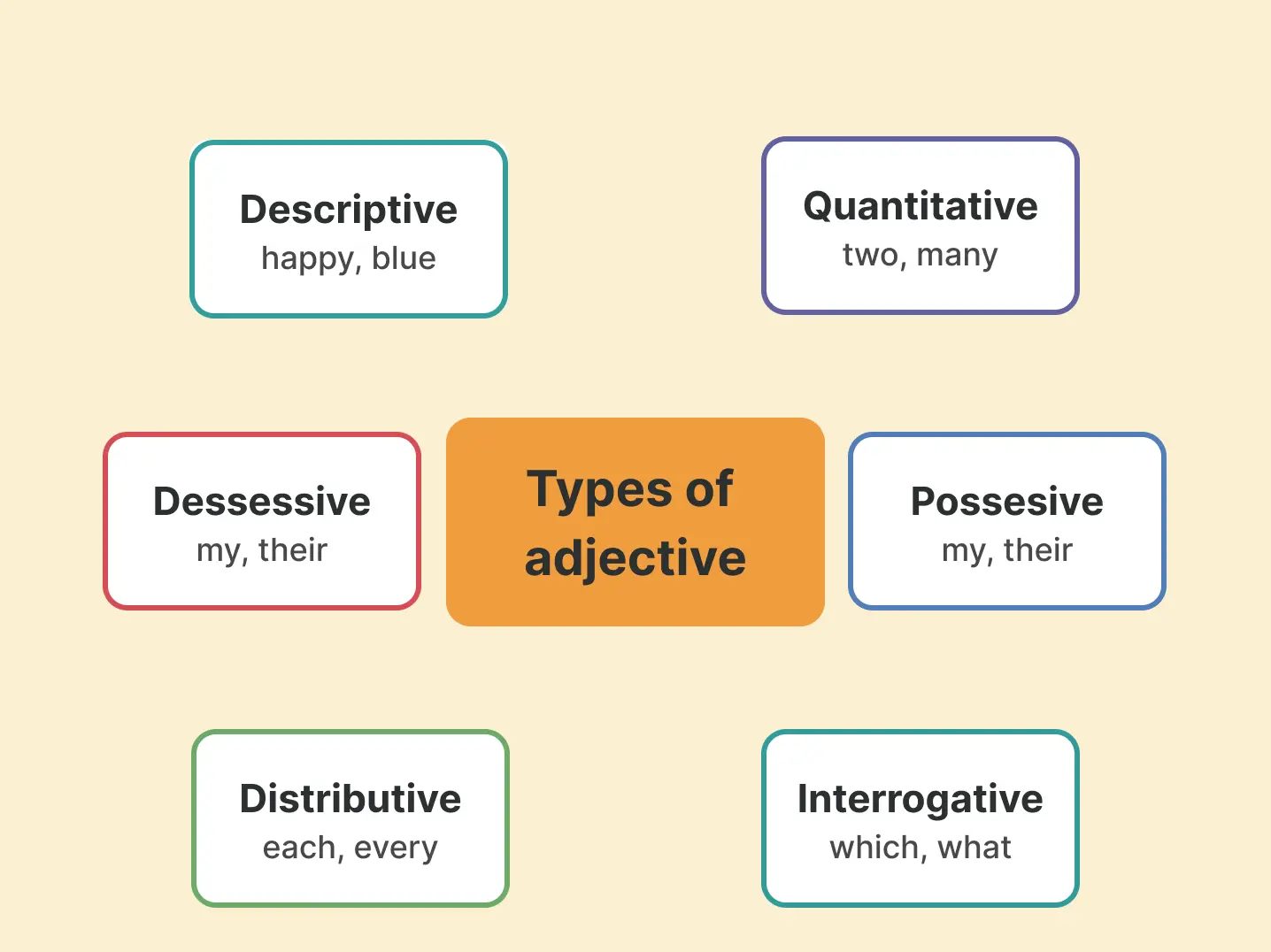
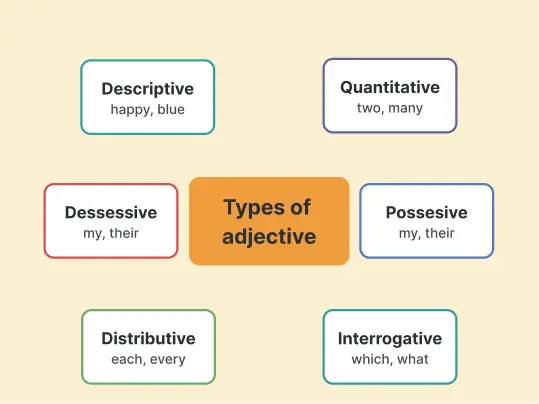
Adjectives in English function as lenses for your words, drawing attention to specific aspects and highlighting your creativity. You may create sentences that are not just educational but also visually and emotionally captivating by understanding how each kind functions.
Overview of categories
To make things clearer, here’s an introduction to the main types of adjectives and the role each plays in shaping your sentences. Below you’ll find a list of adjectives that highlight these categories in practice.
| Type | Purpose | Example |
|---|---|---|
| Descriptive | Describe qualities or characteristics |
playful, melodic, cozy
|
| Quantitative | Show quantity or amount |
several, few, dozens of
|
| Demonstrative | Point out specific nouns |
that, these, this, those
|
| Possessive | Show ownership or relation |
her, our, its, my, their
|
| Interrogative | Used in questions |
which, what, whose
|
| Distributive | Refer to individual members of a group |
each, every, either
|
Exploring the main groups
Adjectives come in all shapes and sizes, each one leaving its own mark on the nouns it describes. The main groups show how they work in action, and everyday examples of adjectives make them easy to spot.
-
Descriptive adjectives
They’re the mood-setters of a sentence, capable of shifting a flat description into something warm, sharp, or striking.
Theancient tree towered over the park.She wore apatched jacket that told stories of countless adventures.Thefizzy soda spilled across the picnic blanket.
-
Quantitative adjectives
Numbers and amounts come alive with quantitative adjectives, answering “how much?” or “how many?”
He hasseveral ideas for his science project.Only ahandful of tickets remain for the concert.There arehundreds of seashells scattered along the beach.
-
Demonstrative adjectives
Such a type helps the reader or listener understand your meaning by pointing to particular nouns.
This recipe calls for unusual spices.Those bicycles need new tires.I can’t decide betweenthese variants.
-
Possessive adjectives
A possessive adjective in English grammar indicates ownership or relationships, showing who something belongs to.
Her notebook was filled with doodles.Their garden is bursting with vegetables.Our apartment overlooks the river.
-
Interrogative adjectives
These adjectives appear in questions, clarifying which noun you are asking about.
Which laptop model do you recommend?Whose shoes are by the doorWhat flavor of ice cream did you buy?
-
Distributive adjectives
Distributive adjectives highlight individuals in a group, focusing on each one separately.
Each employee received a welcome gift.Every corner of the museum was filled with artworkEither candidate could lead the team successfully.
As you grow comfortable with these forms, adjectives become tools for persuasion as well as description. They shape how readers see, feel, and react without them even realizing.
Degrees of comparison


You can compare attributes, draw attention to disparities, and draw attention to the extremes using the system of positive, comparative, and superlative degrees. Understanding the adjective’s meaning makes this tool even more powerful.
Language would be flat without this tool, like a painting with only one color. It gives you a wide range of expressive options.
Positive degree
The positive degree is the starting point, the plain form of the adjective. It simply describes a noun without comparing it to anything else. For example:
Here, cold, tall, and quiet illustrate basic usage. Learning about adjectives in English grammar makes it clear that the positive degree simply describes a noun’s inherent qualities.
Comparative degree
When you want to compare two things, the comparative degree steps in. It tells you who has more or less of a certain quality. The recipe is simple:
- For short adjectives, add -er: smaller, faster, wiser.
- For longer adjectives (usually two syllables or more), use more or less: more relaxing, less predictable, more practical.
For instance:
Rules for short vs. long adjectives
We must underline that an adjective in English behaves differently depending on its length. A short word like soft adds -er or -est, while a longer adjective, such as captivating, uses more or most to compare.
Words with more than one syllable, such as adventurous, refuse the -er and -est endings, so you form more adventurous or most adventurous. Two-syllable adjectives can be flexible, and usage may vary.
Short adjectives:
- thin → thinner → thinnest
- bright → brighter → brightest
- slow → slower → slowest
Long adjectives:
- remarkable → more remarkable → most remarkable
- expensive → more expensive → most expensive
- generous → more generous → most generous
Exception: there are some two-syllable exclusions:
- friendly → friendlier → friendliest
- simple → simpler → simplest
- narrow → narrower → narrowest.
English is full of quirks, so knowing an adjective in grammar helps you master the correct use of comparative and superlative forms.
Irregular forms


Of course, some adjectives refuse to follow the rules. These irregular forms are common enough that they stick in memory:
- good → better → best
- bad → worse → worst
- far → farther/further → farthest/furthest
- little → less → least
- many/much → more → most
Take a look at these demonstrative examples:
Irregular forms can surprise learners, yet each one holds a trace of historical development in the language.
How to use them correctly?
The arrangement of English adjectives and word construction are two important areas to concentrate on. Alongside the adjective definition, we’ve prepared clear guidelines that will help you write and speak in a clearer, more interesting, and more understandable manner.
Word adjective formation

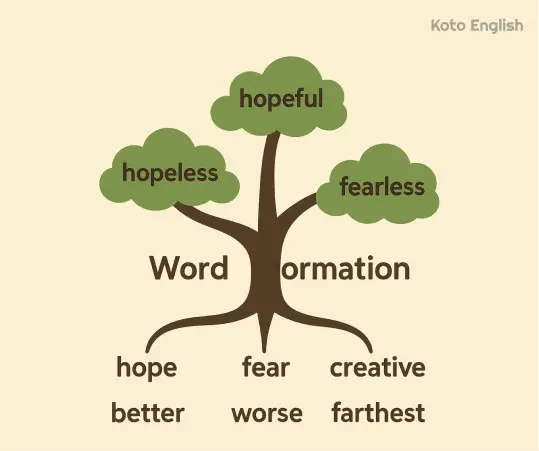
By appending well-known endings, adjectives frequently originate from nouns, verbs, or even other adjectives. You may broaden your vocabulary and enhance the flow of your writing and reading by detecting these patterns. See the following adjective examples and popular formations:
| Suffix | Examples |
|---|---|
| -ful |
joyful, grateful, playful, colorful, powerful, wonderful, spiteful, thoughtful, youthful, careful
|
| -less |
hopeless, fearless, tireless, effortless, careless, countless, meaningless, powerless, endless
|
| -able / -ible |
readable, enjoyable, predictable, flexible, portable, understandable, washable, agreeable, visible, reversible
|
| -ous |
dangerous, adventurous, fabulous, curious, mysterious, glamorous, spacious, victorious, nutritious
|
| -ic |
heroic, poetic, artistic, athletic, dramatic, energetic, metallic, academic, oceanic
|
| -ish |
childish, selfish, foolish, greenish, bluish, bookish, snobbish, clannish, tallish
|
| -y |
sunny, snowy, stormy, spicy, creamy, muddy, dreamy, frosty, sticky, breezy
|
| -ive |
creative, talkative, competitive, attractive, explosive, imaginative, supportive, persuasive
|
| -ent / -ant |
dependent, resistant, vigilant, important, elegant, observant, dominant, significant, abundant
|
Suffixes transform basic words into vivid descriptors: hope turns into hopeful, radiating positivity, while fear becomes fearless, conveying boldness.
Order of adjectives in English
English likes its adjectives in a particular order to keep descriptions smooth and clear. The usual sequence is:
Opinion → Size → Age → Shape → Color → Origin → Material → Purpose


This hierarchy makes sentences easy on the ear, avoiding a messy adjectives list that confuses the reader. Observe this:
- Opinion: stunning
- Size: massive
- Age: ancients
- Shape: square
- Color: black
- Origin: French
- Material: stone
- Purpose: —
- Opinion: lovely
- Size: small
- Age: new
- Shape: rectangular
- Color: blue
- Origin: —
- Material: glass
- Purpose: jewelry
The following amusing mnemonic can help you recall the sequence:
Only Smart Adjectives Seem Clever Organized Making Perfect sense → O S A S C O M P
Common mistakes
Sometimes, even the most meticulous writers make missteps when using adjectives words. You may avoid uncomfortable or misleading phrasing and make your phrases shine by being aware of frequent mistakes. Here are some common errors to be aware of:
- Confusing adjectives with adverbs
Using adjective words when an adverb is required is a common mistake. Adverbs alter verbs, adjectives, or other adverbs, whereas adjectives describe nouns. For instance:
|
She sings loud.
|
She sings loudly.
|
|
He spoke angry.
|
He spoke angrily.
|
To avoid this mistake, ask yourself: Am I describing a thing (noun) or an action (verb)? If it’s a noun, use an adjective. If it’s an action, reach for an adverb.
- Double comparisons
English also frowns upon double comparisons—adding more than one marker of comparison in the same adjective.
|
This painting is more prettier than that one.
|
This painting is prettier than that one.
|
|
The test was more easier than yesterday’s.
|
The test was easier than yesterday’s.
|
These small redundancies can trip up even native speakers, so it helps to read your sentences aloud and listen for any extra more or most.
- Wrong order of adjectives
Stacking adjectives incorrectly can make sentences awkward or difficult to follow. Remember what we were discussing above: English has a preferred sequence: Opinion → Size → Age → Shape → Color → Origin → Material → Purpose. An adjective list following this order helps keep your sentences clear and natural. Breaking this order can confuse readers:
|
She bought a red Italian beautiful large silk scarf.
|
She bought a beautiful, large red Italian silk scarf.
|
|
He adopted a brown tiny cute young puppy.
|
He adopted a cute, tiny, young brown puppy.
|
Correct adjective placement makes descriptions clear, precise, and pleasant to read.
- Overuse of adjectives
More is not always better. Overloading a noun with adjectives can overwhelm the reader and make the sentence feel heavy.
|
He wore a stylish elegant dazzling sophisticated luxurious jacket.
|
He wore a stylish, elegant jacket.
|
|
She gave me a sweet kind generous thoughtful caring note.
|
She gave me a caring note.
|
Listing a few weak or comparable adjectives is often less effective than selecting two or three powerful ones.
- Mistakes in the degree of comparison
Not all adjectives work well with superlative and comparative forms. Some have unique regulations, while others cannot be compared. The following are common pitfalls that students encounter:
|
fun → funner
|
fun → funnier
|
|
modern → moderner
|
modern → more modern
|
If a word feels absolute (like unique, perfect, dead), don’t compare it. If it’s longer or irregular (modern, far), use the accepted forms.
Keep these traps in mind, and your writing will carry authority and grace. Your descriptions will guide the reader smoothly, instead of tripping them up.
Enjoy personalized learning!
Quick practice quiz
Although practice makes perfect, adjectives add vitality to your words. Before going on to the next chapter, try the following exercises to see how well you understand it and can define an adjective in different contexts.
Practical tips for using
A solid grasp of the definition of an adjective enables you to enrich your writing, giving your descriptions depth, clarity, and impact. These tips will help you craft sentences that are vivid, precise and memorable.
-
How to add variety to writing
Repetition of the same adjectives can make the text dull. Mix things up by using a range of words to describe feelings, sizes, colors, or qualities. As a case in point, rather than mentioning big severally, you can use other terms, such as huge, massive, spacious, or immense.
Changing the descriptors keeps the reader locked in, and it elaborates the picture.
The other method is the use of adjectives in pairs in an artistic way. A cozy little cabin and a small cozy cabin feel different even though the two describe the same object. The shift of sequence can help alter the tone and the emphasis.
-
When to simplify
Although adjectives add color to writing, several of them may overload the writing. Simplification is essential. Be questioning yourself whether any adjective will actually be adding value.
As an example, the combination of words such as a stunning, beautiful, gorgeous sunset might be just a stunning sunset, or a gorgeous sunset. A single well-considered adjective can go farther than a series of adjectives of a similar type.
Also, it has to be reduced when your audience has a fast reading speed. Concise descriptions preclude misunderstandings in technical writing, journalism or instructions. A simple sentence, such as the spacious conference hall, passes on the information with no feeling of overpowering the reader, compared to the large, spacious, well-lit conference hall.
-
Synonyms and vocabulary expansion
Widening your horizons of adjectives expands your ability to write in a more descriptive and accurate manner. Make an inventory of the synonyms and study slight variations between the words. Happy, joyful, elated and content all have a positive connotation, but just at a different level of intensity or tone.
Reading numerous works: books, essays, poetry, can make you encounter a lot of adjectives in various contexts. The meaning of an adjective helps you see how writers appeal to sensations with strange or powerful expressions of description.
Thesauruses are an aid that you can employ, yet see that there is the correct synonym applicable to the setting, as not all synonyms can carry the same undertones.
Finally, practice actively and continue to learn English with Koto. Try rewriting sentences with different adjectives or challenge yourself to replace common words with more colorful alternatives. For instance, instead of tired, you could write weary, exhausted, or drained, depending on the tone you want to convey.
Conclusion
The spark of language comes from adjectives. They make your work more interesting and memorable by transforming simple nouns into vibrant images. You can describe them clearly and stylishly if you know their types, degrees, and correct order.
Adjectives will become organic in your writing and voice as you practice. Select carefully because sometimes one powerful word is better than many. Your English will always feel vibrant and colorful if you use the appropriate adjectives.
FAQ: Common questions about adjectives in English
Adjectives describe nouns and pronouns, telling us more about people, places, or things (e.g., a tall building). Adverbs describe verbs, adjectives, or even other adverbs, usually explaining how, when, or to what extent something happens (e.g., She runs quickly). Think of adjectives as answering “What kind?” and adverbs as answering “How?”
Yes, in English, adjectives in grammar sometimes appear without an explicit noun. For example, “The rich should help the poor” uses adjectives as nouns referring to groups of people. In casual speech, you might also hear phrases like “I’ll take the red” when talking about cars, shirts, or other items where the noun is obvious from context.
Most adjectives form comparatives with -er or more, but some break the rules. As we noted above, examples include good → better → best, bad → worse → worst, and far → farther/further → farthest/furthest. These irregular forms need to be memorized because they don’t follow the usual patterns.
Not all. Some adjectives, especially absolute ones, don’t logically allow comparison. Words like perfect, unique, dead, or infinite describe an absolute state, so saying “more perfect” is technically incorrect (though you might see it in rhetoric). Many longer adjectives, like beautiful or interesting, use more and most instead of adding endings.
In certain cases, yes. Adjectives can take on a noun-like role when they represent a group or abstract idea. For instance, “The elderly need special care” uses elderly as a noun referring to older people.



